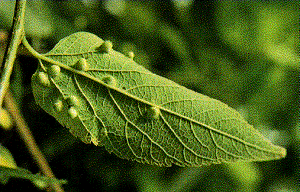|
 The yellow and black insects commonly called sweat bees are
actually flies. Syrphid flies to be
correct. Sweat bees are about a quarter of an inch long, and are
usually a metallic green in color When in doubt, count the wings (I
know – easier said than done). Bees will have two wings per side,
while flies have one. The yellow and black insects commonly called sweat bees are
actually flies. Syrphid flies to be
correct. Sweat bees are about a quarter of an inch long, and are
usually a metallic green in color When in doubt, count the wings (I
know – easier said than done). Bees will have two wings per side,
while flies have one.
Syrphid fly is a generic name given to an entire group of flies.
There are some differences in appearance and color, but the
yellow and black color is the major one in our area. The other
names for syrphid flies are hover flies or flower flies. They
tend to hover around your arms and face when you have been
perspiring, and land to lap up the sweat. They are also commonly
found on flowers, hence the flower fly name, and do a good job
of pollinating.
Syrphid flies are actually beneficial insects. They help
pollinate, larvae feed on dead organic matter, and the larvae
are predators of aphids. They cannot sting, but their mouthparts
can usually be felt when lapping up sweat from sensitive areas.
You may feel a slight pinch which makes you feel like you’ve
been stung or bitten.

Hackberry Tree Leaf Problems
There is a disease of hackberry leaves that appears as blocky
yellow spots. The spots often have green tissue surrounding them
(but not always), so the disease has earned the name of island
chlorosis. In addition to causing the yellowing symptoms, the
chlorosis can cause some leaf drop. The disease is mainly a
curiosity on established hackberry trees, and causes little
damage.
The other item of note on hackberries is the presence of the
hackberry leaf gall, which appears as a “thimble shaped” leaf
swelling. See the general gall information below.
[to top of second column] |

Galls

One group of problems showing up is galls. Galls are swelling of
leaves, twigs, or other plant parts. Most are caused by mites or
wasps. They damage the plant parts and the plant responds with a
gall. In the case of leaves, the swelling is actually leaf
tissue. This is something I like to refer to as similar to you
getting a mosquito bite. The damage comes in and a swelling
occurs. There is no way to get rid of it without tearing a small
hole in the leaf. The maple leaf bladder gall will be easily
spotted on silver maples in the area shortly, and oak leaves in
the red oak group are also showing galls.
Oak trees probably have more galls than any other group of
trees. Several samples have also been brought in of the stem
types of galls. Fortunately, the oak galls are usually not the
type to kill tissue beyond them. However, the galls aren’t the
most pleasant things to look at. That is the main thing – they
are unsightly.
There is no cure for galls, as they are caused by insects before
you see the swellings. The timing would be impossible to try and
prevent the insects.
[By JOHN FULTON, COUNTY EXTENSION
DIRECTOR SERVING LOGAN, MENARD, AND SANGAMON COUNTIES] |